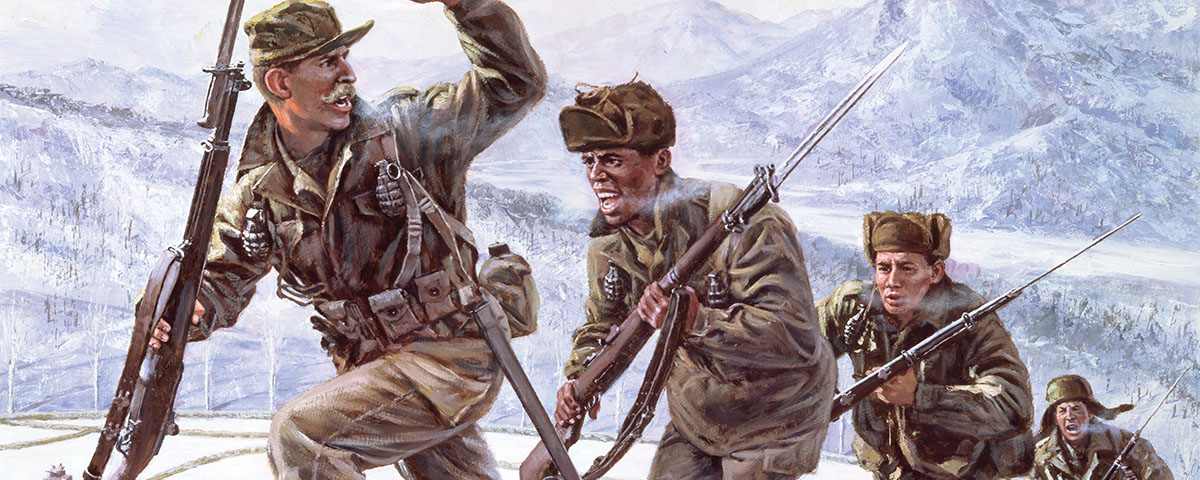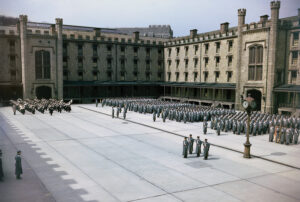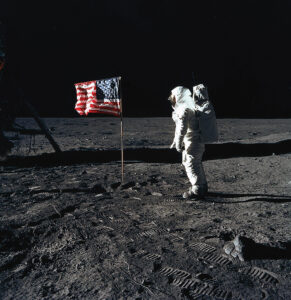Fix bayonets and follow me!” shouted Captain Lewis Millett as he led Company E, 2nd Battalion, 27th U.S. Infantry Regiment, in a Feb. 7, 1951, charge against entrenched Chinese positions atop Hill 180 during the Korean War. Millet received a Medal of Honor for the action, which U.S. Army historian S.L.A. Marshall called “the most complete bayonet charge by American troops since [the 1864 Battle of] Cold Harbor.” Each year U.S. and South Korean military personnel commemorate what is known as the Battle of Bayonet Hill with a ceremony at the hilltop memorial on what today is the U.S. Air Force’s Osan Air Base [www.osan.af.mil]. Unfortunately, the memorial is on the wrong hill.
On Dec. 26, 1950, Lt. Gen. Matthew Ridgway arrived in Korea to take command of the Eighth U.S. Army, which was retreating in the face of the unexpected Chinese intervention in South Korea. A hard-charging general who had commanded airborne units during World War II, Ridgway set out to improve morale and regain the offensive. He focused on the basics of attack and defense, how to take high ground and how to secure flanks from infiltration. His first test of these reforms was Operation Thunderbolt, launched on Jan. 25, 1951. It took only one day to recapture the North Korean–held city of Suwon, and by early February the front lines were just south of Anyang, a satellite city of Seoul, some 18 miles north of Osan.
After the battle historian Marshall interviewed members of Company E and wrote Millet’s MOH recommendation. “On the first morning after the big charge at Anyang-ni we assembled the company,” Marshall wrote. “The big hill was right at hand. The critique was conducted in and around a tent no more than 500 yards from its base.” He drew a diagram and took several photos of the battlefield. His account makes it clear the action occurred not near Osan but near Anyang. The unit history Battleground Korea: The Story of the 25th Infantry Division confirms the division was near Anyang and includes a diagram showing the units of I Corps positioned north of Suwon. Among the participating elements was the 24th Infantry Regiment, which had a unit newspaper titled Eagle Forward. On February 7, the day of the battle, the paper reported: “The Eighth Army commander, Lt. Gen. Matthew B. Ridgway, braved enemy fire to take a personal look at the fighting north of Anyang and at one point was within 1,000 yards of enemy positions. At least 500 Chinese Reds were killed and 1,500 wounded by the two task columns alone.”
Clearly, Anyang was central to Ridgway’s efforts, and the Hill 180 on which the action occurred must have been nearby. The original Medal of Honor record is the key to pinpointing its exact location. The first clue is the map number, Sheet 6326 II. But that map depicts a body of water nowhere near either Osan or Anyang, so the number must be incorrect. The actual map is Kunpojang, Sheet 6526 II—only one digit off the mistaken number—which features Anyang. The MOH record identifies the battle grid coordinates as 108-410, which convert to 37.3964752, 126.8625671. Overlaying the coordinates with the elevation places the battle just west of Anyang, and a comparison of present-day photos to Marshall’s record shows a clear match for the location—a hill at the junction of Expressways 330 and 17.
The only known counter to such an argument is Millett himself, who visited Osan as early as 1975 to attend the ceremony and returned often, sometimes as the featured speaker. He obviously believed Osan to be the correct location. In the 24 years from 1951 to 1975 Korea had modernized at a stunning pace. Those familiar with Korean topography also understand how difficult it is to identify individual spots in the ubiquitous mountainous terrain. Millett was likely escorted to the wrong location, where the mistake was already lore, and never questioned his hosts. No documentary trail explains why Osan Air Base was considered the correct location, but it is clear the battle did not happen there.
Company E fought with valor at the Battle of Bayonet Hill. Ridgway had found in Millett the leader he was looking for—an aggressive, offensive-minded officer who led from the front. During the bayonet charge—a brutal but effective tactic familiar to countless generations of soldiers—Millett embodied the reforms Ridgway was encouraging. On Feb. 11, 1951, Ridgway wrote a personal note to IX Corps commander Maj. Gen. Bryant Moore and attached it to Marshall’s battle account, writing, “This ought to make good reading for every infantryman.”





